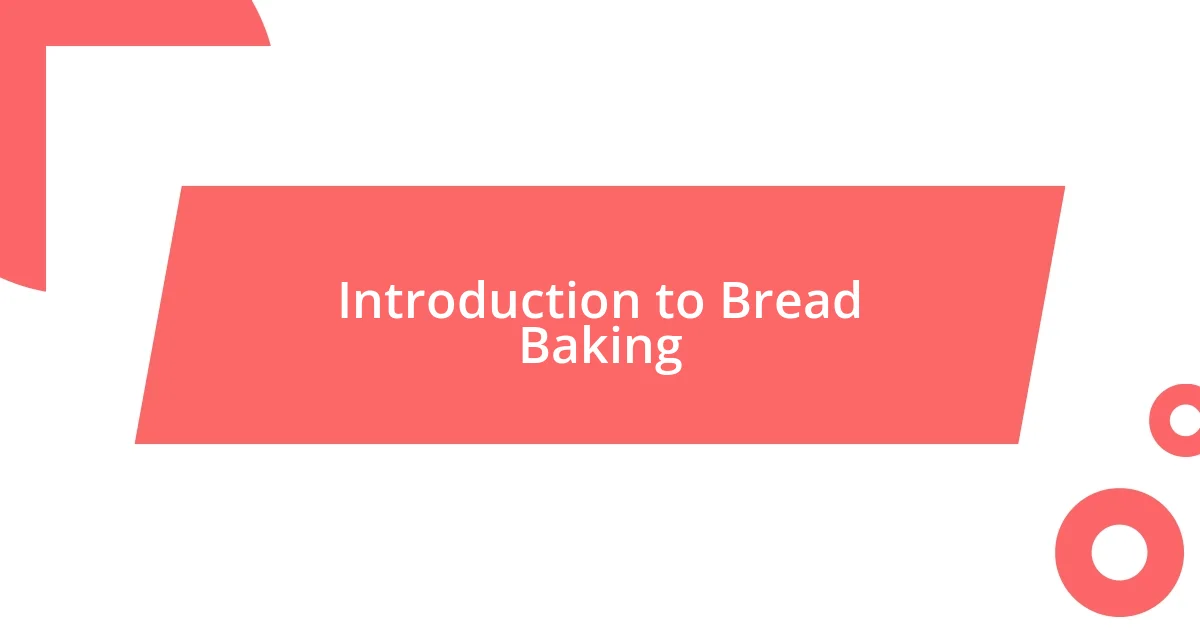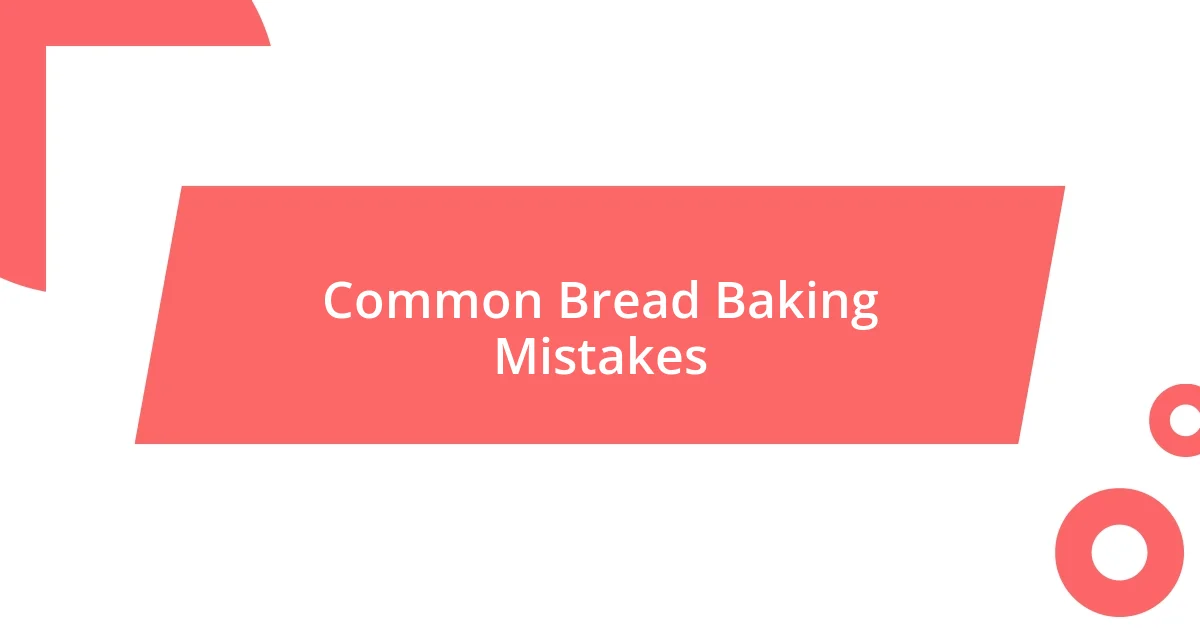Key takeaways:
- Bread baking combines science and creativity, making it a rewarding culinary art that fosters connection and joy.
- Understanding ingredients (flour, water, yeast, salt) and their roles is crucial for achieving the desired texture and flavor in bread.
- Key techniques for success include precise measuring, proper fermentation time, and maintaining the right temperature, along with engaging your senses during the process.

Introduction to Bread Baking
Baking bread is more than just a culinary skill; it’s an art form steeped in tradition and warmth. I remember the first time I pulled a freshly baked loaf from the oven—the golden crust crackled as I gently tapped it, and the aroma was nothing short of intoxicating. Have you ever experienced that moment when your heart races with anticipation, waiting for something you’ve made from scratch?
As I delved into the world of bread baking, I discovered that the process is a beautiful blend of science and creativity. The way flour, water, yeast, and salt come together is fascinating. Did you know that yeast is a living organism? Watching it grow and bubble is like witnessing magic unfold right before your eyes.
Each loaf tells a story, whether it’s a simple rustic bread or an elaborate sourdough. I often think about the joy of sharing that first slice with friends or family—there’s something comforting about gathering around a fresh loaf. This is what makes bread baking so special: it connects us, creating unforgettable moments one loaf at a time.

Understanding Basic Ingredients
Understanding the basic ingredients of bread baking is crucial for achieving that perfect loaf. I often recall the first time I experimented with different types of flour. All-purpose flour worked well, but using bread flour enriched my loaf with a beautiful chewiness. Flour isn’t just a component; it plays a starring role in determining the bread’s texture and flavor.
Water, on the other hand, is the unsung hero. I learned that the ratio of water can make or break the dough. Too little, and you’re stuck with a dense loaf; too much, and you end up with a sticky mess. It’s fascinating how something so elemental can transform the entire baking experience. During one of my baking trials, I switched from tap water to filtered water, and the difference was noticeable. The dough felt more pliable, and the bread rose beautifully.
Yeast and salt also bring unique characteristics to the mix. Yeast activates the fermentation process that makes the bread rise, while a little salt enhances flavor and strengthens the gluten structure. I remember a batch where I mistakenly added too much salt. The loaf was edible, but it taught me that balance is essential in bread baking—too much of anything can ruin the harmony of flavors.
| Ingredient | Function |
|---|---|
| Flour | Provides structure and texture |
| Water | Activates gluten and yeast |
| Yeast | Causes fermentation and rising |
| Salt | Enhances flavor and strengthens dough |

Essential Bread Baking Tools
When it comes to bread baking, having the right tools can make all the difference. I still remember the thrill of my first loaf of sourdough; it was a delicious mess because I didn’t have the proper equipment. Using a few essential tools can elevate your bread-making experience significantly. A good kitchen scale, for instance, allowed me to measure ingredients precisely, helping me achieve consistent results. I fondly recall the first time I weighed my flour instead of using cups—it was a game changer!
Here’s a list of essential bread baking tools that I highly recommend:
- Kitchen Scale: Ensures accurate measurement of ingredients for perfect consistency.
- Mixing Bowls: A set of various sizes is beneficial for both mixing and proving dough.
- Dough Scraper: This handy tool helps manage sticky dough and makes clean-up a breeze.
- Bench Knife: Perfect for cutting and shaping dough, giving you more control.
- Proofing Basket: I love using these for shaping dough; they help provide structure during the final rise.
- Baking Stone or Steel: A solid base for achieving that delightful crust when baking.
- Instant-Read Thermometer: Ensures your bread is perfectly baked by measuring internal temperature.
Investing in these tools made my journey smoother and more enjoyable. I often smile thinking about the time I finally treated myself to a high-quality dutch oven; it transformed my baking game, allowing me to replicate that bakery-style crust I always craved.

Step-by-Step Bread Making Process
The bread-making process is a delightful journey that begins with combining the dry ingredients. I remember the first time I mixed flour, yeast, and salt together; it felt like alchemy. As I added the water, I watched the transformation—the dry ingredients turning into a shaggy dough. Have you ever felt that excitement of creating something from scratch? It’s that moment of magic when you realize you’re on the right path.
Next comes kneading, which I find therapeutic. There’s something incredibly satisfying about pushing and folding the dough with my hands. When I first attempted kneading, I was unsure if I was doing it right. Yet, as I continued, I developed a rhythm and a feel for the dough. If you’ve ever lost track of time while kneading, you know exactly what I mean—it’s both a workout and a meditative experience that leaves you connected to your creation.
Once the dough has risen, the real fun begins—shaping. I vividly recall the first time I shaped a baguette; it felt like an art form. Smoothing the dough with my hands and tucking it in was a step where I truly discovered my creative flair. And while I was proud of my baguette, I learned that each shape comes with its own unique drying and baking time. Shaping requires patience, but the reward of a beautifully baked loaf makes every moment worthwhile. Don’t you think the art of shaping is what really adds personality to your bread?

Techniques for Perfect Dough
When it comes to achieving perfect dough, hydration is key. I used to think all doughs were created equal, but adding the right amount of water changed everything for me. I remember the first time I experimented with higher hydration dough; it was a bit sticky to handle, but the end result was a beautifully airy loaf with a crust that crackled just right. Have you ever tasted bread so light it felt like eating a cloud? The secret is in balancing moisture with flour.
Another essential technique is developing gluten. At first, I struggled with understanding how gluten worked. I often wondered if I was kneading enough or too much. Through trial and error, I discovered the stretch-and-fold method, which allowed me to build structure without overworking the dough. It felt empowering to see my dough rise beautifully with just that minimal effort. Have you found joy in watching dough transform through simple actions like this? It’s those little techniques that add depth to the final product.
Finally, don’t underestimate the power of patience during the fermentation process. I remember waiting nervously during my first bulk fermentation, constantly peeking under the plastic wrap. Over time, I learned to embrace that wait. The longer fermentation not only deepened the flavors but also improved the dough’s structure, resulting in a loaf that had a lovely, complex taste. Isn’t it fascinating how time plays a crucial role in baking? Each moment of waiting is a step toward deliciousness.

Common Bread Baking Mistakes
One of the most common mistakes I’ve encountered in bread baking is not measuring ingredients accurately. Early on, I often used the scoop-and-pour method for flour, thinking it wouldn’t make a difference. I learned the hard way that a cup of flour could vary significantly based on how it was packed, leading to dense loaves that could double as doorstops. Have you ever found yourself frustrated by inconsistent results? It’s essential to use a scale for precision in your measurements.
Another pitfall is rushing the fermentation process. I remember anticipating the smell of freshly baked bread so much that I’d often cut the rising time short. The bread might look lovely, but it didn’t have that airy texture and complex flavor I craved. Trust me, allowing your dough to ferment properly transforms not just the taste but also the overall baking experience. Have you ever tasted a loaf that didn’t quite meet your expectations? That’s likely a sign that patience is just as important as technique in the art of bread making.
Lastly, overbaking is a mistake that can turn a promising loaf into a disappointment. I still recall the first time I let my bread bake too long; I was so fixated on getting it golden brown that I lost track of time. The result? A loaf that could practically crack a window. It taught me to pay attention to not just color, but sound and smell too. Have you learned to listen to your bread as it bakes? The perfect crust sings a delightful chorus as it cools, reminding me that sometimes, it’s about trusting my instincts in the kitchen.

Tips for Bread Baking Success
When it comes to achieving bread-baking success, one thing I’ve found invaluable is maintaining the right temperature. I remember the excitement of baking on a sunny day when my kitchen warmed up nicely, only to realize that my yeast was working overtime! The result was a loaf that burst with flavor but ended up a little too airy for my liking. So, what’s the ideal temperature? I believe that keeping your ingredients, especially water and dough, at a comfortable room temperature can make all the difference in achieving that perfect rise.
Another critical tip is to always trust your senses. I’ve had moments when I wondered if my dough had risen enough, and instead of relying on recipes alone, I started to feel it. The texture, the bounce back when poked—it all became part of my process. Isn’t it amazing how engaging with your bread can lead to better results? Each batch of dough tells its own story, and listening closely helps me make informed decisions during the baking process.
Finally, I can’t stress enough the importance of a good preheating routine, particularly if you’re using a baking stone or Dutch oven. There was a time when I overlooked this step, and my bread turned out pale and flat. That experience taught me how vital it is for the oven to be hot enough to create that stunning crust. Have you ever experienced the satisfaction of pulling a loaf from the oven that looks just like the ones in bake shops? It’s a reminder that these small details—like a proper preheat—set us up for the ultimate bread baking glory.















